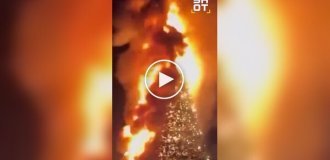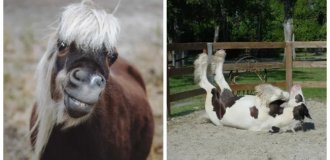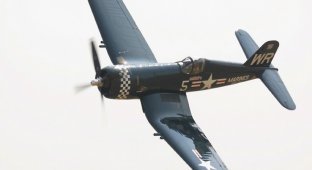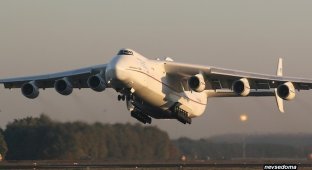The aircraft, which became a milestone not only for Soviet but also for world aviation, was designed under the leadership of the “king of fighters” N. Polikarpov. The I-16 became the world's first serial fighter with retractable landing gear.

This low-wing aircraft of mixed design had a relatively short fuselage with a shape close to a teardrop shape (which corresponded to the then ideas about aerodynamics). To improve the maneuverability of the I-16, it was deliberately designed to be insufficiently stable (the center of gravity coincided with the aerodynamic focus) and extremely compressed in size (which ensured low moments of inertia around all axes).


Alas, such “minimalism” also had a downside - the aircraft did not have significant reserves for modernization, and there was no possibility of installing more powerful, and therefore heavier, engines.
In parallel, 2 prototypes were built for 9-cylinder air-cooled engines: TsKB-12 for the M-22 (480 hp) and TsKB-12bis for the American Wright Cyclone F2. The first of them entered testing on December 30, 1933, and the second a few days later.


Already in 1934, the aircraft was put into serial production at factories No. 39 in Moscow (where only 58 aircraft were built) and No. 21 in Gorky and adopted by the Red Army Air Force. Total production at Plant No. 21, which ended in early 1941, exceeded 8,500 units.



In the second half of the 30s. "Donkey" was one of the main combat aircraft of the Red Army Air Force. The combat debut of the I-16 type 5 vehicles took place in the fall of 1936 in Spain, and in the spring of 1938 they were joined by the I-16 type 10. A total of 276 I-16s and 4 UTI-4s were delivered to Spain.



Another 4 I-16 type 10 were built at the La Rabasa plant. 22 I-16 and 2 UTI-4 became trophies of the Francoists; in addition, until 1941 they completed 30 I-16s at the La Rabasa plant. The Spanish Air Force operated I-16s until 1950.




I-16s were used very widely in China - only from October 1937 to September 1939, 216 such aircraft arrived in this country, and in 1940-1944. 30 UTI-4 were assembled in China. As in Spain, both local pilots and Soviet volunteers fought in them. Some Chinese I-16s flew until 1944.



In mid-1939, Soviet I-16 types 10, 17, 18 took part in the battles at Khalkhin Gol. It was here that I-16s first tested RS-82 rockets in combat. In September 1939, regiments armed with I-16s took part in the Red Army campaign in Western Ukraine and Western Belarus. I-16s also played a very important role in the Soviet-Finnish war - by the beginning of it on November 30, 1939, about 800 fighters were concentrated near the borders of Finland, of which 410 were donkeys. It is characteristic that the majority of I-16 combat sorties were carried out to attack ground targets. The most effective were the Type 17 cannon aircraft.



Captured I-16s were used in Finland - 1 aircraft of this type was introduced into the Air Force in 1940. But very soon it was transferred to the Germans for testing. The Finns commissioned another 5 in 1942-1943. Having received them, for the most part, from the Germans. In addition, in September 1941, the Finnish Air Force was replenished with one UTI-4 - a two-seat version of the I-16.



On the eve of Germany's attack on the USSR, in the border districts there were 57 IAPs, fully or partially armed with I-16s. They had 1,635 aircraft of this type, which accounted for about 40% of the fighter aircraft fleet of the border districts. Another 344 I-16s were part of the Air Force of the Black Sea, Baltic and Northern fleets.



Despite the surprise of the attack, it was the regiments armed with I-16s that provided the most active resistance to the Luftwaffe - already at dawn on June 22, in the skies over Brest, the pilots of the 33rd IAP achieved their first victories, and by the end of the day the 67th IAP of the Odessa District chalked it up to their own 15 enemy aircraft shot down. The first Heroes of the Soviet Union in the Second World War were also I-16 pilots who shot down enemy aircraft with ramming attacks - P. Kharitonov, S. Zdorovtsev, M. Zhukov.




However, the losses of the Red Army Air Force were very significant - by June 30, there were only 873 I-16s at the front, of which 99 required repairs. Nevertheless, “donkeys” continued to be one of the main types of Soviet fighters and were actively used on all fronts and fleets not only in 1941, but also later.



For example, the 13th IAP of the Baltic Fleet, covering the “Road of Life” across Lake Ladoga, from March 12 to April 13, 1942, shot down 54 enemy aircraft, losing only 2 I-16s. He successfully operated on the I-16 and 72nd (later 2nd Guards) mixed air force of the Northern Fleet Air Force, in which B. Safonov fought. To compensate for losses, it was necessary to send early-graduated aircraft from schools and reserves to the front.



Thus, in 1942, the 728th IAP, armed with I-16 type 5, fought on the Kalinin Front. At the end of 1941, approximately 240 I-16s remained on the Soviet-German front, and this number was maintained at approximately the same level until the middle 1942


Probably the last time I-16s were used en masse was in May 1942 near Kharkov, where about 70 aircraft of this type operated. There were much more “donkeys” in air defense units - in the summer of 1942 their number reached 350 units.


In 1943, the number of I-16s in combat units decreased sharply - in the middle of the year there were only 42 such aircraft at the front. About three dozen were operated by naval aviation (21 of them by the Baltic Fleet Air Force) and 143 by air defense aviation. By the end of the year, there were practically no I-16s left at the front. Only in the Far East they were used until 1945, but they no longer took part in the war against Japan - more modern machines were enough.





Despite the fact that by the beginning of the Second World War the I-16 was already outdated and could not fight on equal terms with more modern enemy fighters, it played an important role in the battles of the initial period of the war. Many subsequently famous Soviet aces began their combat careers on this stout monoplane.

Main modifications:
I-16 type 4 - M-22 engine. Armament - 2 7.62mm wing-mounted ShKAS machine guns. 555 vehicles were built: 50 in 1934 by plant No. 39 and 505 in 1934-1935. plant No. 21.
UTI-2 type 14 - two-seat training version with M-22 engine. In 1935-1936 Plant No. 21 built 45 aircraft.
I-16 type 5 - version with the M-25A engine (licensed version of the Cyclone F3). The armament is similar to the I-16 type 4. 109 aircraft additionally received 2 7.62-mm PV-1 synchronous machine guns, 41 aircraft for aerobatic teams were built without weapons. In 1936-1938. 2695 aircraft were produced.

I-16 type 12 - analogue of the I-16 type 5 with reinforced armament (2 20-mm ShVAK cannons and 2 ShKAS machine guns in the wing). In 1937-1938 built 22.
UTI-4 type 15 is a two-seat unarmed training aircraft based on the I-16 type 5 airframe with an M-25A and then an M-25B engine. In 1936-1941. 1846 vehicles were built.
I-16 type 10 - M-25V engine (750 hp). Armament - 4 ShKAS machine guns (2 synchronous in the fuselage, 2 in the wing). In 1938-1939 934 of these aircraft were produced.
I-16 type 17 - analogue of the I-16 type 10 with the wing machine guns replaced by 2 20-mm ShVAK cannons. In 1938-1939 341 cars were produced.

I-16 type 18 - M-62 engine (800 hp). Armament - 4 ShKAS machine guns. In 1939, 177 units were produced.
I-16 type 24 - M-63 engine (900 hp). Armament - 4 ShKAS machine guns. In 1939, 155 were manufactured; In addition, in 1940, another 760 I-16 type 18 and type 24 aircraft were produced.
I-16 type 27 - a cannon version of the I-16 type 18. In 1939, 59 units were produced.
I-16 type 28 - cannon version of the I-16 type 24. In 1939-1940. 293 released.

I-16 type 29 - the last production version with the M-63 engine. Armament - 3 synchronized machine guns: 1 12.7 mm BS (ammunition capacity 130-230 rounds) and 2 7.62 mm ShKAS (475 rounds for the left and 500 for the right). Under the wing there is a suspension of 6 82-mm NAR RS-82. In 1940-1941 650 aircraft were manufactured.
In addition to the specified machines produced by plant No. 21, I-16 aircraft were produced by a number of other enterprises. Thus, Novosibirsk plant No. 153 in 1937-1941. produced 270 I-16 early modifications with the M-25 engine, 19 I-16 type 24 and 907 UTI-4.

Plant No. 458 in Rostov-on-Don (evacuated to Baku at the beginning of the war) produced only UTI-4, having been built in 1941-1942. 439 aircraft. Some of the 83 vehicles produced in 1942 were manufactured in the assault version, known as type 15B. Such aircraft were armed with 2 12.7-mm BK machine guns in the center section, and under the wing they had units for hanging 6 RS-82 and 2 50-kg aerial bombs.
In addition, 143 I-16 aircraft were delivered to the USSR in 1941 from aircraft assembly plant No. 600 (Urumqi, China). Thus, the production volume of I-16 exceeded 10 thousand units, with approximately 1/3 being training vehicles.

























